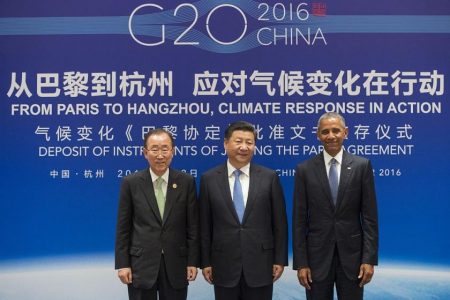September 4, 2016 – Yesterday the two largest greenhouse gas emitters on the planet formally agreed to the commitments made in Paris last December. The leaders of both countries in the presence of the Secretary of the United Nations, Ban Ki-moon, provided notice of ratification with President Obama declaring this is “the moment we finally decided to save the planet.”
Xi Jinping, President of China, exhorted other countries to ratify the deal before year end. He declared that China will “adhere to the green low-carbon development cycle….saving resources and protecting the environment.” He further stated that China will “promote green development, but also…take the initiative to address climate change and overcapacity.”

For COP21 to go into effect 55 of the 195 nations who signed on have to ratify it. And those 55 nations must represent 55% of global emissions. So far 24 have done so. Until the United States and China came on board the previous 23 countries represented just 3% of global emissions. With China and the United States on board the total is now up to 41%.
China has committed to cutting carbon emission intensity based on units of GDP to the tune of 50-65% by 2030 from 2005 levels. It is also committed to creating 20% of its energy requirement from non-fossil fuel sources by that date. It also commits itself to reforestation to increase tree volume by 4.5 billion cubic meters from 2005 levels. Emission intensity, however, is by no means emission reduction. It is the same argument that oil sands companies in Canada have used in pledging their efforts to tackle greenhouse gas emissions. The only difference is the oil companies track it by intensity per barrel of oil produced.
China should have no trouble meeting its pledge because as an effort to tackle global warming it comes up exceedingly short. Based on intensity China’s overall emissions will grow well past the 2030 deadline it has set before we see an overall decline. The hope is the country will revise these targets to be more aggressive in the next round of COP negotiations.
The United States committed at COP21 to reduce net greenhouse gas emissions by 26-28% below 2005 levels by 2025. This is a real reduction target as opposed to China and if current policy persists beyond the next presidential election, the United States should easily meet its goal within the timeframe. But this plan too is not ambitious enough to lessen the pace of warming and keeping average global temperatures from rising 2 Celsius (3.6 Fahrenheit) degrees or more by the end of the century.
For the latest on how all countries who were signatories to COP21 are doing visit Climate Action Tracker, a website that provides an assessment of every nation’s plan. You may find the analysis of climate change commitments by G20 countries currently meeting in China most interesting.
















